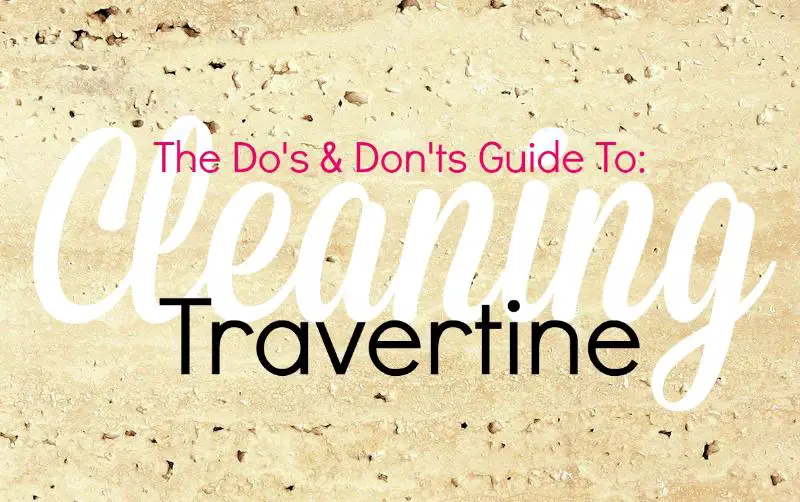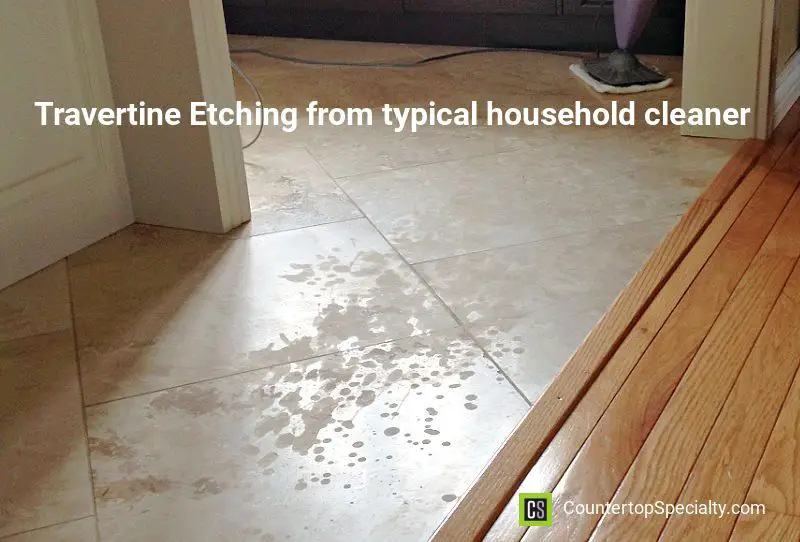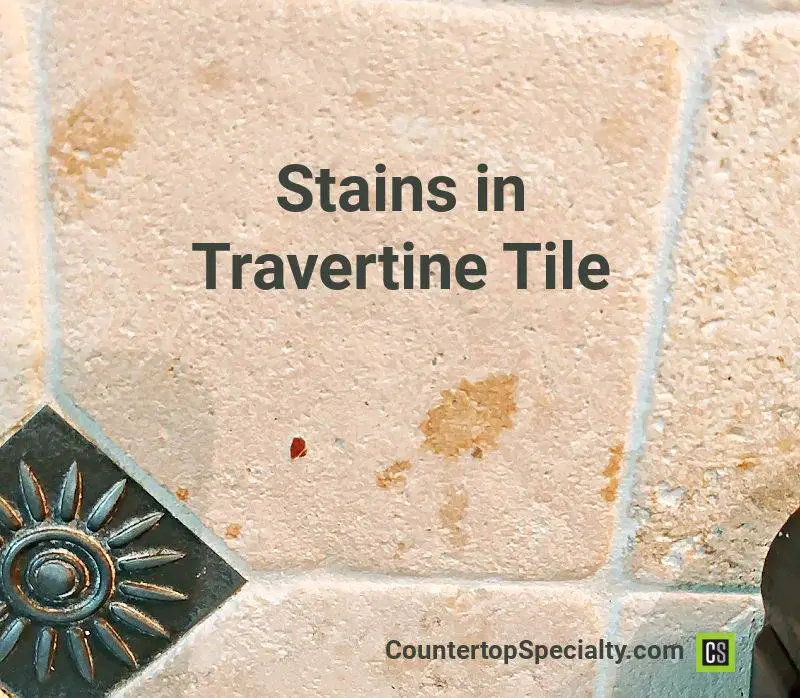The Complete Guide to Cleaning Travertine
Cleaning travertine is easy... but it's important to know what you are dealing with. Once you learn about the characteristics of travertine and apply the simple "How To" secrets detailed below your travertine will look fabulous for decades.

ON THIS PAGE
First of all, travertine is a warm and beautiful material that will complement almost any design from chic to rustic.
Travertine is a natural stone, but not nearly as dense or hard as granite. It is durable, wears well and will last lifetimes.
But in a way, it is delicate which is why you need to follow specific guidelines below and learn about sealing, stains, scratches, and etching. I cover it all below so let's go!
PRO TIP: The information provided about etching, staining, cleaning and sealing travertine applies to countertops as well as travertine floor tiles, showers or any other location travertine is installed.
How To Clean Travertine: Step-by-Step
Step #1:
Clean off all dust and debris using a soft damp cloth or sponge on countertops and tables. Sweep floors with a standard broom but a dust mop works much better to remove small particles that wear down the finish over time.
Step #2
Apply an appropriate travertine cleaner for the demands of the area to be cleaned. For example: Effectively cleaning a travertine shower requires a different cleaner formula than for floors or countertops, tables, and backsplashes.
Step #3
Wipe, scrub or mop the surface with a non-abrasive sponge, brush, or mop to remove all grease, grime, and gunk.
A plastic scrapper can be used to remove stuff stuck on the surface.
Use a grout brush to clean dirty grout lines.
Step #4
Rinse with water if needed according to the product instructions. Quality stone cleaners for countertops and floor tile will not need rinsing.
Step #5
Buff dry and remove streaks with a clean cloth, chamois, or mop.
NOTE: The best cleaners will dry streak-free.
What is the Best Cleaner for Travertine?
A non-abrasive and pH-neutral natural stone cleaner is a must for travertine cleaning. For quick cleanups, warm water is fine. However, for regular cleaning, a dedicated travertine tile cleaner will yield the best results and avoid etching the finish (see more on etching below).
The specific type of product you choose will depend on which area of your home needs cleaning.
- For cleaning travertine floor tiles use the Stone Care Tile Floor Cleaner and a quality microfiber mop. It is a concentrate formulated for the heavier soils on floors. Just mix with water. It does not require rinsing and dries streak-free. No hassle.
- For cleaning travertine countertops use the Granite & Marble Spray Cleaner. It's a ready-to-use, high-quality cleaner that dries without streaks. Perfect for travertine tables as well.
- For cleaning travertine showers use this Soap Film & Hard Water Remover. Soap film (and hard water if you have it in your area) are the major cleaning issues for showers requiring a specific formula. However, common generic and brand-name bath cleaners are too harsh and will etch travertine.
Can you clean travertine with soap and water?
Avoid using soap to clean travertine or any natural stone. Soap is commonly recommended and will not damage travertine, but a soap scum film will build up with frequent use (just like in the shower). Soap scum will occur no matter how much you rinse, making your countertop, table, or tile look dull and dingy.
What Causes Etching On Travertine?
Acidic foods, drinks, and harsh cleaners etch travertine. Travertine is a calcite-based natural stone that is sensitive to acids and caustic substances. These will corrode or eat away the travertine surface, causing a dull etch mark that may look clear or chalky. Etching is like a chemical burn. But you can repair etching.
Etching occurs on other calcite stones like marble, limestone, and onyx too.
So spills of acidic foods and drinks like fruit juice, coffee, and wine will immediately etch (dull the polish or finish).
Many common household cleaners (generic and brand-name) are too harsh and damaging for use on travertine and other types of natural stone.
See the "Don'ts" and FAQ sections below for specific cleaners you should not use for travertine care and cleaning.

Etching can be repaired on travertine tile and countertops using these handy DIY products depending on the type of finish:
- Polished (shiny) finish: Etch Remover - Marble Polishing Powder
- Honed or tumbled finish: Etch Remover Polishing Pads - Drill Kit
Because of the "etching" issue, travertine is not recommended for your kitchen countertop or a high-use bathroom. Although, a travertine backsplash over the kitchen countertop will look fantastic and won't be problematic.
Travertine flooring has a much lower risk of etching so long as you use the proper cleaner.
Best use of travertine is for powder bathroom vanity tops, table tops, tub surrounds, showers, floor tile and stone fireplace surrounds.
Travertine can stain as well. But note that etching is different from staining.
I will discuss stains and sealing in the sections below.
PRO TIP: travertine, marble, limestone, and onyx are so similar in composition, chemical and physical characteristics that cleaning procedures and maintenance requirements are essentially the same for all three types of stone.
Download our comprehensive ebook: Cleaning Marble Secrets.
- This ebook details every technique, method and solution along with all the information and answers you will ever want or need about protecting, maintaining, repairing, restoring and cleaning travertine tile, marble, limestone, or onyx.
Learn all about travertine and why it is so similar to marble and limestone.
Stains In Travertine
Travertine is a porous stone and will stain if foods, oils, or other substances are left on the surface too long. Stains create dark spots vs. etching that creates dull or chalky light-colored spots.
 Grease stains in travertine tile backsplash
Grease stains in travertine tile backsplashCuriously though, the porosity and likelihood of a stain depends on the type of finish (tumbled, honed, polished).
Polishing travertine closes down the pores and makes travertine less absorbent so it will not stain nearly as easily as a honed or tumbled finish.
A honed finish is satin smooth but more porous than a shiny polished finish.
A tumbled finish has a raw and rustic look that is the most porous and prone to staining (like the backsplash tile in the photo above).
Remove travertine stains using the Marble & Granite Stain Remover Poultice.
Fresh stains are usually easy to remove. Old and deep stains may take some extra work or may be permanent.
Why is my travertine turning black?
Travertine tile or pavers may gradually turn black due to mold and mildew growth inside all the pores and holes of this stone. Mold growth occurs in moist or wet areas like showers, sinks, bathroom floors, pool decks, and patios.
Use a Mold & Mildew Cleaner safe for travertine to kill the mold. You likely will need to let it soak and then scrub as needed. Rinse well and repeat until all mold is removed.
If it's deep into the stone you may not be able to get it completely clean. You could then try power-washing or steam cleaning depending on the area (indoors or outdoors). But it still may not remove it all.
In dry areas, dust, dirt, and grime can collect in the holes eventually turning the travertine tile black.
The Heavy Duty Tile Floor Cleaner is the best choice safe for travertine in dry areas. But ground in grime is really hard to remove.
Once clean, fill all the holes with grout or a travertine filler.
Gases released during the formation of travertine create the holes and gaps of various sizes which are easily seen with the naked eye. But many tiny pores exist in the stone as well.
Usually, these hole are filled before the travertine is polished or honed or during installation.
If left unfilled, then mold will quickly grow inside the holes and pores or grime may fill the holes gradually turning the travertine black in spots or potentially across large areas.
Sealing Travertine
You may have read about sealing your stone and maybe that sealing travertine is a hassle, but I assure you it’s no big deal. Simple as... "wipe on - wipe off".
The time and cost involved is really inconsequential when compared to how fabulous travertine countertops and floors look in your home — not to mention the added value when compared with other surfaces.
Travertine can stain when honed or tumbled, but polished travertine is nearly stain-proof and usually doesn't need sealing.
Recommended Tips:
- Perform the water test for sealing travertine to determine if a sealer is needed. Apply only if testing shows it is needed.
- All sealers are not created equal. Don't waste your time or money on ineffective sealers that won't last.
- I've used most common sealers (StoneTech, Miracle 511, SCI, Granite Gold, Weiman, Aqua Mix) and most are very average.
- Applying a top-quality sealer like these that I highly recommend will ensure durable, long-lasting stain-protection to maintain your investment in like-new condition.
NOTE: Sealing travertine tile will guard against "stains" but not "etch marks".
This is also true for sealing marble and limestone. But this fact is generally unknown by most consumers and confusing since people typically call any spot a "stain". But there is a difference.....
Sealers are applied to protect against "stains" which are a specific type of spot that occurs when a substance absorbs into the stone.
Etching is corrosive damage from contact with acidic foods, drinks or cleaners much like a burn. Because etching is physical damage to the stone a sealer cannot prevent etching.
Learning and following the best travertine cleaning practices outlined in the next section will help minimize the occurrence of etching.
Do's & Don'ts for Cleaning Travertine
Use the following Do's and Don'ts to learn how to clean travertine, help you avoid bad habits and establish a safe method for travertine care and maintenance.
Also, check out the General Care & Cleaning Guide for the best tips on maintaining all types of countertop surfaces and floor tile.
Do: Sweep & Mop Travertine Tile Flooring Regularly
Use a clean, dry, non-treated dust mop or broom. Don't use a vacuum cleaner on your travertine flooring. Worn parts or grit jammed by the wheels may scratch the surface.
Also, mop regularly using a specialized Stone Floor Tile Cleaner.
PRO TIP: A polished travertine finish on floor tile makes a very slick surface, so go with a "honed", "flamed" or "tumbled travertine" floor tile finish. It will look warm and inviting and hide dust and smudges better between cleanings.
Polished travertine tile looks great, however, it will require more frequent cleaning and maintenance. Foot traffic will eventually wear away the shine, although, it can be restored with professional repolishing.
Do: Use Doormats, Runners, and Area Rugs
Grit, dirt and sand carried in by our shoes are abrasive and will wear and scratch travertine floor tiles.
So, be sure to place doormats both outside and inside. Use runners and area rugs for high-traffic locations.
However, also be sure to clean the rugs regularly and remove them to clean the travertine tile as well.
Do: Blot Up Spills Right Away
Travertine tile is much more sensitive than granite to acidic substances like wine, coffee, fruit juices, tomato sauce, sodas, toiletry products and cleaning products that can etch (dull) the finish (on both shiny "polished" and matte "honed" finishes) or stain the surface.
Do: Clean With a Soft Cloth or Sponge
For travertine countertops the only cleaning agents you should use on a regular basis are hot water to wipe up crumbs and small messes and then a stone cleaner once daily (or as needed for bigger messes).
I recommend the Granite & Marble Spray Cleaners here. Buff dry with a cotton cloth or chamois.
Using a mild soap for cleaning travertine is often suggested and it won’t harm the stone, but consistent use of soap will leave a dull and dingy soap scum buildup on the surface.
Do: Use Coasters, Cutting Boards and Trivets
Bottles, cans and glasses with acidic drinks may etch the polish or damage the finish leaving a "glass ring" or dull spot from etching on travertine tables and countertops.
So make travertine maintenance easy and avoid expensive travertine restoration and polishing by treating your travertine surfaces like fine wood furniture. Always use coasters... no matter what.
Do: Use a Tray for Bathroom Toiletry Products
A decorative tray can look very nice and it will protect the countertop surface from the damaging chemicals contained in many toiletry products.
In travertine showers, be sure all shampoo and other bottles are closed and not leaking to prevent stains or etching.
Do: Fill the Holes in Travertine
Travertine's distinctive voids and holes should be filled upon installation to keep dirt from accumulating or mold forming. These holes are formed from gases released during the formation of travertine and add to that rustic look. But the holes only cause maintenance problems.
Most travertine tile and slabs will you buy will already be filled. Often tumbled travertine is not. But holes can be filled upon installation with grout or a travertine filler.
Don't: Use Generic or Typical Household Cleaners
Cleaning travertine with the typical products bought at your local store will generally damage travertine.
Most contain acids, alkalis, and other chemicals that can etch travertine or degrade the sealant leaving the stone more vulnerable to staining.
It may not happen right away and trying to save money by using cheap, generic surface cleaners only ensures that you'll spend a lot more time and money on your travertine tile care in the long-run performing expensive repairs or travertine restoration.
Don't: Use Vinegar, Ammonia, Bleach, or Citrus Cleaners
Vinegar, hydrogen peroxide and cleaners with lemon or orange are acidic and will etch the finish leaving dull chalky spots.
Bleach and ammonia are highly alkaline and also too caustic for travertine tile cleaning. These will also cause etch marks.
As noted above, a sponge with hot water and a stone cleaner are the only agents to use.
Don't: Use Common Bathroom, Tub & Tile or Grout Cleaners
The powders and even the "soft" creams contain abrasives that will scratch and dull the surface. And again, these types of products are either too acidic or too alkaline and harsh for safe use as a travertine tile cleaner.
Also, do not use lime scale removers like Lime-Away or CLR to remove hard water deposits. These are highly acidic and will etch.
Instead use the Hard Water & Soap Scum Remover. This product is made specifically for safe use on travertine and all natural stone.
Use only products specially formulated for cleaning travertine like the STONE CARE products recommended.
Don't: Drag Furniture Across Travertine Floors
Travertine can be scratched easily. It is a soft natural stone like marble and limestone so don't drag furniture or anything else across the surface of travertine tile.
The Etch Remover - Marble Polishing Pads DIY Drill Kit or Manual Kit can repair shallow or surface scratches. Deep scratches may require professional refinishing or replacement of the scratched tiles.
Don't: Sit or Stand on Travertine Countertops
Unlike laminate countertops, travertine countertops are not flexible and they DO NOT have a plywood backing, so too much weight in one spot could cause a crack on either tile or slab counters.
Don't: Set Toiletry Products Directly on Travertine
Hair products, toothpaste, perfumes, colognes, nail products, creams, soaps, shampoos, lotions, and potions may stain or damage the surface or etch the finish leaving a dull spot or ring.
Use a removable stainless steel rack or product organizer in the shower. This will dramatically reduce the chance of stains or etching.
If you have built-in shower shelves or insets then ensure the bottles are rinsed, closed, and not broken or leaking.
Protect your countertop by placing personal products on a decorative tray like they do in fancy hotels!
FAQ: Cleaning Travertine
Is baking soda safe on travertine?
Baking soda is abrasive and not safe for use on travertine as it will scratch or dull a polished or honed finish. Also, it may cause etching in some cases.
Can you use Magic Eraser on travertine?
Do not use a Magic Eraser on travertine. Magic Erasers seem like soft sponges, but they are abrasive and will scratch and dull the tile or countertop finish.
Can you use Clorox Wipes on travertine?
Avoid using Clorox Wipes on travertine. Clorox Wipes contain bleach or citric acid, which will cause etching (dull spots of corrosion) on travertine, marble, and other natural stone.
Can I use Swiffer Wet Jet on travertine?
Using a Swiffer Wet Jet on travertine will damage and etch the surface finish. Swiffer Wet Jet is too alkaline and harsh (pH 10) for safe use on travertine. Use only natural stone cleaners with a neutral pH (~7).
Can I use a steam mop on travertine?
A home steam cleaner with lower temperatures (200-250 F) is okay to use sparingly on travertine. But the pressurized vapor and heat of any steam cleaner can cause spalling where the stone flakes or pits if used regularly. It can also wear away the finish dulling polished travertine.
Putting It All Together
OK. It may seem like there is a lot to do and know about travertine care. But if you think about it, many of the Do’s and Don’ts are things you already do and don't do!
The nuts and bolts of how to clean travertine are really very easy. It boils down to using products made for travertine and knowing how to avoid damage.
The Roman Colosseum is made of travertine, so we know it is durable. Plus, travertine can be repaired or restored in most cases when damaged.
The best advice is to get a separate cleaning tote for your travertine cleaning products. Label everything and off you go--no problems or guesswork.
This is especially handy if you use a cleaning service. You’ll never have to worry that you or the maid might accidentally use the wrong product. Cleaning travertine is simply a matter of routine.
Just keep in mind that travertine has stood the test of time and it is meant to be used. So with just a little TLC, you’ll enjoy its beauty for years.
Also, products safe for use on travertine are the best choices for other natural stone in your home such as granite countertops and manufactured stone-based materials like quartz or Corian.
Snag a Countertop Specialty coupon code and save on all the travertine cleaning, sealing, or repair products you may need.
Cleaning Travertine Questions & Answers
Learn even more! Click on the links below to see questions submitted by other visitors with complete answers and great info.
Cleaning Grout & Sealing Travertine Problem
QUESTION: I just had a travertine floor honed surface laid and the installer grouted the tiles and then put an impregnating sealer enhancer on the tile. …
Removing Streaky Travertine Sealer
QUESTION: I installed polished travertine flooring (Jinshan Carmel P/F) which my installer sealed with an unpolished sealer.
The results were streaked …
Travertine Maintenance Sealing & Cleaning Answers
QUESTION: I've installed brand new travertine floor tile.
I've heard that you must have it buffed and sealed.
Do professionals have to come …
Sealing Travertine Shower
QUESTION: Should I put a sealer on my new travertine showers and floor tile?
ANSWER: Yes... and No... let me explain about sealing …



